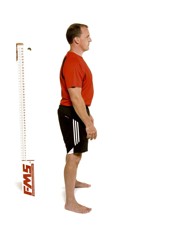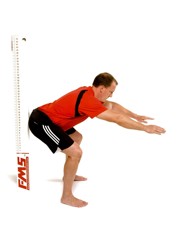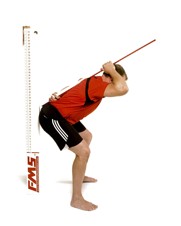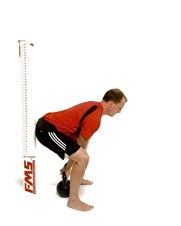Deadlifting Tips
Brett Jones CSCS, Master RKC, CK-FMS
January 26, 2010 08:54 AM
Picking up a weight or object from the floor is an essential skill. While that may initially strike you as an odd or over the top statement I would like you to pause for a moment and think of how often you have to bend down in some fashion in order to pick something up. A child, a bag of groceries etc… and if you are a Kettlebell athlete the
deadlift is the slow strength pattern that
forms the foundation for your swings and snatches.
The goal of these Deadlifting Tips is to provide some pointers that will get you in better position for your deadlift and maybe help with the execution of the lift as well.
First you must know that a deadlift is a
Hip Hinge activity
NOT a squatting activity.
What is the difference? In the most generic terms a hip hinge
moves the hips back and the squat moves the hips down. The quickest way to find the difference is to use a drill we simply call a "Touch the Wall" drill.



Stand a foot width from the wall and reach back with your hips to touch the wall. This should happen "quickly" and quite high on the wall. If you are successful move an inch or so from the wall and try again. You will find your maximum distance from the wall when you cannot touch the wall without "falling" back into the wall slightly. Once you find that point wiggle back a bit so you successfully touch the wall with a solid base. You may use a stick along the back to feel the proper spine alignment by keeping the stick touching the back of your head, thoracic spine and sacrum during the entire movement. A Kettlebell may even be placed between the heels to pick up so you groove the deadlift movement. Begin to incorporate your breathing sniffing in to a tight stomach while reaching back to the wall then forcing air out tightly on the way up.

 Important points here:
Important points here:- Work with your trainer to establish your best breathing pattern. It might incorporate a slight breath hold (if approved medically).
- Do not PULL the weight up – rather PUSH your feet into the ground and try to push yourself under the weight. Pulling on the weight and initiating the movement with the upper body instead of a push down with the hips and feet will throw stress into the lower back.
- Grip - Begin deadlifting with a double overhand grip. This will increase the stress or work on your grip and keep the weights lower initially while you are learning how to deadlift. Once you have improved your form you can switch to an alternate grip where one had is palm forward (underhand) and the other is palm back (overhand).
- Stance – Conventional (hands outside of legs and a narrower stance) or Sumo (hands inside of legs and a wider stance) – Try both and see which one feels best and allows for the best form for you.
- Do not be in a rush either to pick up the weight (squeeze it off the floor – don't jerk) or to increase the weight (cycle your weights up and down).
- Squeeze your upper arm against your ribs and get your Lats involved in your deadlift - see pic with arrow. Keep your armpit tight and arms against ribs!
Give these tips a try and remember to take your time learning, grooving and improving your deadlift.
Back